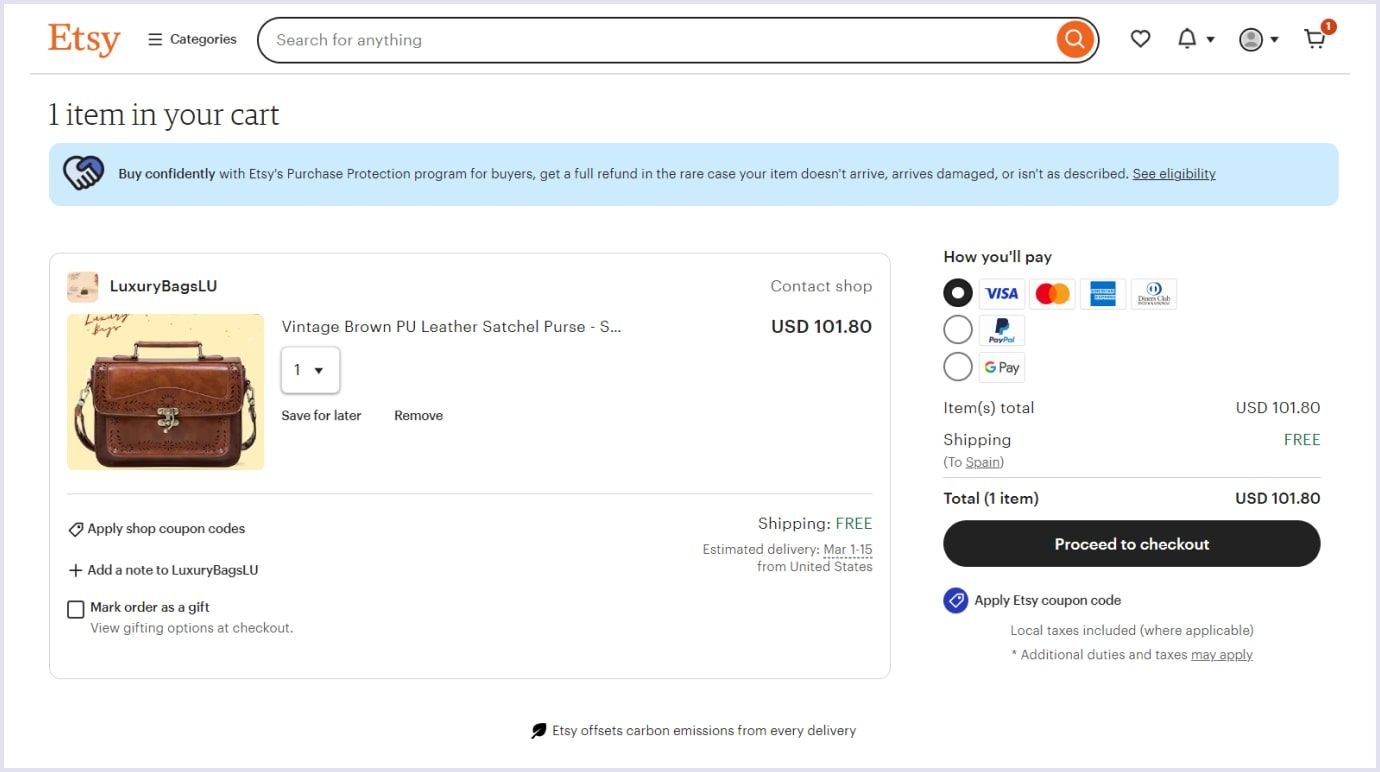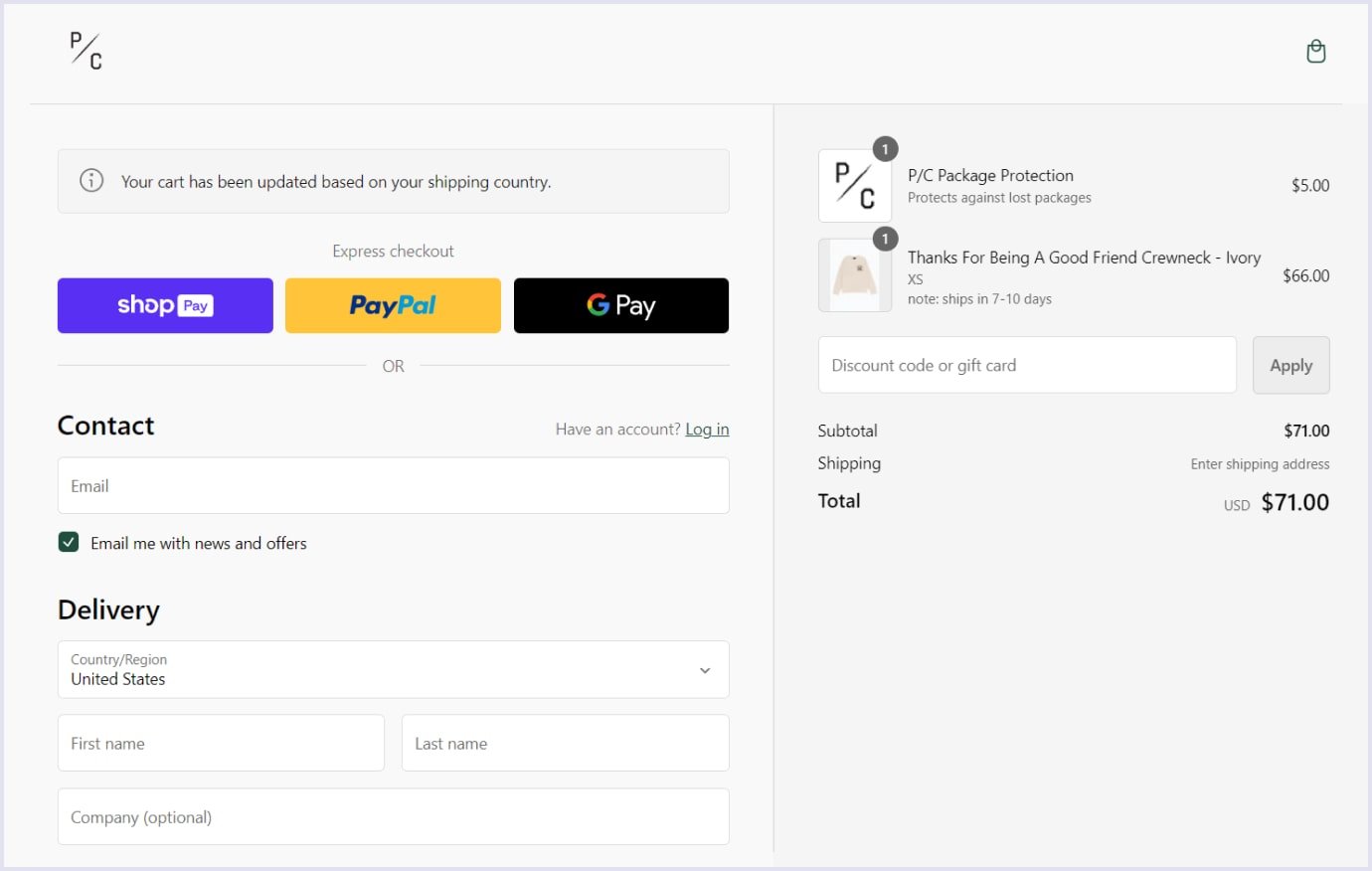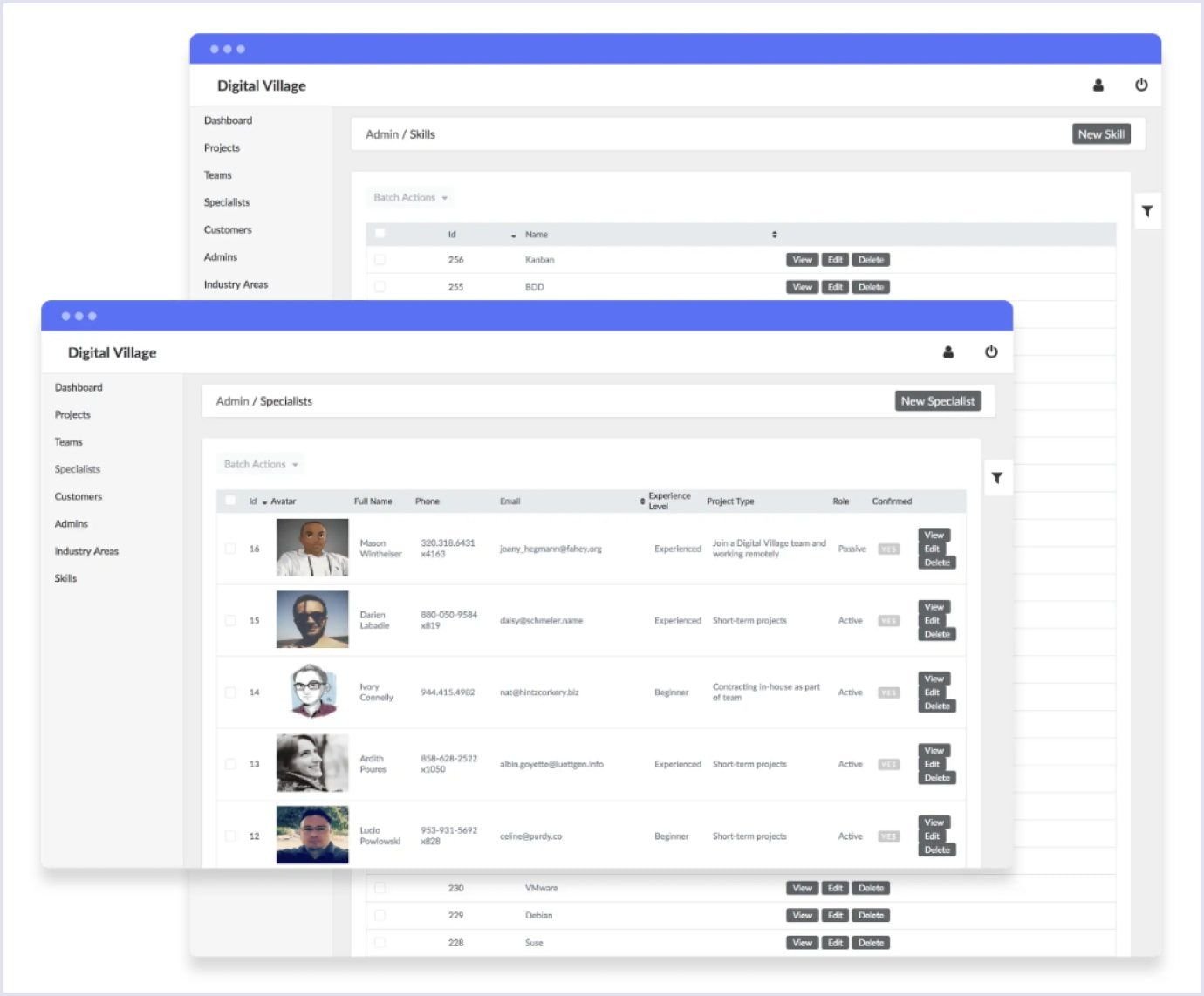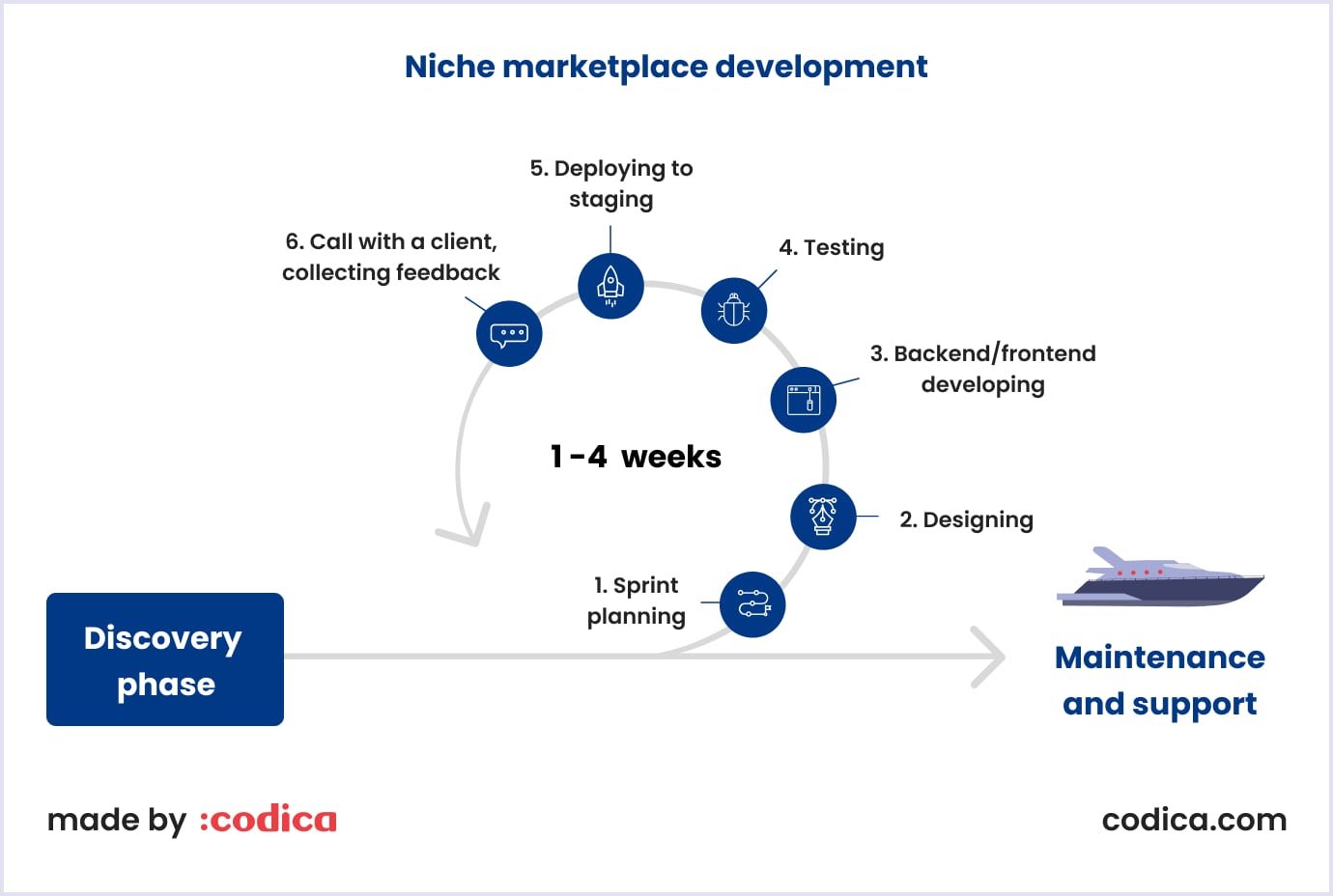Targeting a specific group of customers, category, or industry with your marketplace means having a niche. Creating an online niche marketplace helps gather passionate customers with specific interests. Thus, your marketplace gains stable audience interest, which helps it evolve.
With a decade of building online marketplaces, we share our tips with you. So, this article helps you find your niche, validate your idea, and build a niche marketplace. Time to dig deep.
What are niche marketplaces?
Unlike general platforms, niche marketplaces cater to specific consumers or businesses. A niche platform, also known as a vertical marketplace, focuses on a segment of products or services, demographics, or market locations. So, such business-to-consumer (B2C) and business-to-business (B2B) platforms make curated offers depending on target groups’ interests and specific needs.
The span of a niche marketplace varies by particular goals. For example, Decathlon is a niche marketplace providing sports inventory and accessories. But its coverage is impressive, targeting over 70 sports.
Compared to this, Alltricks has carved out its way in cycling. Thus, cycling enthusiasts get the best equipment and accessories from this European marketplace. It serves all cycling mastery levels, from beginners to seasoned riders.

Benefits of niche marketplaces
When you build an ecommerce website, targeting a specific niche brings you tangible benefits. Narrow focus ensures customer engagement, low competition, and partnership opportunities. Let’s see them in more detail.
As B2C and B2B niche marketplaces attract customers with specific interests, their engagement is genuine. This aspect ensures that such customers are loyal to your platform. You gain higher conversion rates and turnover if you support that interest with high-quality products and discount programs.
Competition in niche ecommerce is also softer than in multi-segment marketplaces. Focusing on a narrow industry or target audience involves fewer players than in the case of a horizontal marketplace with many different categories.
A partnership with complementary brands and influencers is another opportunity for a niche marketplace. Such cross-promotion improves your brand’s visibility and opens doors to scaling.

How do you discover your niche for an online marketplace?
Finding a specialized segment in business for your marketplace takes several steps. You can check your marketplace’s niche demand and validate your plans through them. Let’s see what the steps are and how you approach them.
Identify your skills or a problem to solve
To develop niche marketplace ideas, check on your interests and skills. What are you passionate about? What is your expertise? Starting from a well-known segment creates a solid basis for your niche marketplace.
Another approach is to find and solve a particular problem you have or are aware of. For example, it was the case for an online service marketplace for kids. The founder, David Watkins, wanted to organize leisure time for his children but couldn’t find a proper service. He learned that other parents also had the same issue. So, the idea of the PlanMyKids marketplace appeared.
The platform has a convenient questionnaire upon which it shows leisure options. The results displayed show the activity, time, location, and price. The video below shows how the marketplace looks and works on mobile.
Explore several niches and narrow the selections
Before putting effort into one segment, we recommend researching various sources to find niche marketplace ideas. It will help you in two ways. First, you will find products in high demand. Second, you will prove that these trends will last so that you can inject resources into a viable deal.
Here are some techniques to dive deep into sales trends of niche ecommerce.
- Check trending products on prominent marketplaces. For example, Shopify posts about trending products and things to sell online. eBay suggests eBay Export to help sellers find their ways in trends. Though these are global marketplaces, their trendy suggestions are a source of fruitful ideas.
- Use ecommerce and keyword research tools. Such solutions worth checking include JungleScout, Helium 10, and Algopix. You can search for trending products on Amazon, eBay, and Walmart with them. Also, Algopix helps with product discovery on your niche marketplace ideas.
- Follow influencers in your niche by searching on various social media. Searching social media, discover several influencers who harness trends before others. Also, you can check comments to see what people think of particular products before you develop a niche marketplace.
- Launch a crowdsourcing project. Crowdfunding websites, like Indiegogo or Kickstarter, help you present your idea and see if it gets a following.
When you’ve found several niches, check if you can narrow them down or if there are complementary segments. Therefore, you can assess the starting point for your marketplace.
Validate and test your niche marketplace ideas
To prove your idea before investing, try the market demand by gathering customer feedback. Check tools like Think with Google and Nielsen consumer research for insights on customer pain points, wishes, and trends.
Also, research on your competition. If you have rivals, it proves that the niche is in demand, which is good. The challenge in this case is that you will have to think about your unique selling proposition to gain your audience.
Moreover, you can start testing your niche idea with a blog, YouTube channel, or landing page. If you see interest in your platform or willingness to buy from it, the test has been passed.
Features of ecommerce niche marketplaces
Let’s start with the basic features a niche marketplace should have. These functions will make your ecommerce marketplace software solution appealing to sellers and shoppers.
Product page. Give a comprehensive description of selling items to potential buyers. High-quality photos and videos, detailed descriptions - everything matters.
Shopping cart. As you are developing an ecommerce platform, this option is a priority. Show items added and payment options on the shopping cart page.

Search feature. The chances are that your multi-vendor platform will offer a great number of products. So, it would be reasonable to add a search box when creating a marketplace website. By the way, this is a must-have for the marketplace, and now, the platforms use semantic search with AI (artificial intelligence) for personalized needs.
Security options. Make your marketplace website as secure as possible. SSL (Secure Sockets Layer) certificates, multi-factor authentication, and firewalls will help you protect your product.
Payment methods. Enable users to choose amongst a variety of payment options. The most popular payment gateways are PayPal, Stripe, Braintree, and WePay. For example, Peace Collective offers express checkout with Shop Pay, PayPal, and Google Pay.

Guest checkout. This option helps your shoppers buy fast. With this feature, you help customers simplify buying if they come to your platform for the first time.
Sign in/sign up form. Sign-up improves customer experience. It enables customers to track order processes or view previously purchased items. Finally, registration allows customers to get personalized on-site recommendations.
Admin panel. Simply put, an admin dashboard helps manage everything related to your ecommerce website. For example, this functionality allows you to track orders, payments, and shipping. Moreover, you can view abandoned checkouts and create draft orders.
Below is an example of an admin panel for the Digital Village collaboration platform. The feature lets you view projects, customers, teams, and more.

Wishlists. With this feature, shoppers can create collections of items they want to buy later. When users are ready to purchase, they quickly find the product needed in the wishlists.
Shipping. Enable shoppers to choose the preferred delivery option and offer free shipping at specific purchase amounts.
This is functionality you should consider in the first place when building a B2C or B2B niche marketplace. With these features, you will get a convenient and easy-to-use web solution.
How do you build a niche-focused marketplace?
To develop a niche marketplace, you can choose between two basic options: a pre-built solution or custom software development services.
Pre-built platform
Creating a website with a website builder might be enticing for an online marketplace startup. You can create a niche marketplace with basic features by choosing this option. For example, Shopify offers building marketplaces with its Marketplace Kit.
The kit includes pre-built elements that you can use for creating your online niche marketplace. The elements cover product listings, storefronts, shipping, and checkout.
While using pre-built elements at the start is helpful, it will be problematic to customize the marketplace while it evolves. That is why we recommend turning to custom online marketplace development so you get a solution for your unique business needs.
Custom marketplace
With tailored development, you gain branded UI/UX design, a proven tech stack, and optimized development. Also, you receive continuous support with updates on your niche marketplace. These aspects make your platform recognizable and compelling for repeat purchases.
At Codica, we have a refined process of building niche marketplaces, which takes the following steps.
Product discovery
If you have an idea for a niche marketplace, we recommend you start with product discovery. At this step, we will research your marketplace’s product-market fit, target audience, competitors, and technical side. As a result of product discovery, you get clickable prototypes and recommendations on features, tech stack, architecture, and team composition. Also, we provide you estimates for time and cost of development.
Check the video below to learn why this step is vital for your online marketplace development and see who participates in product discovery.
UI/UX design
As research by WebFX states, websites gain 75% of their credibility from design. If you put effort and money into your website, you make your marketplace credible and gain more sales.
Our UI/UX design services include creating prototypes and selecting colors and fonts to make your marketplace recognizable. Thinking through your navigation, search, filters, payment integrations, and checkout process ensures the convenience and appeal of your marketplace design.
Niche marketplace development
As the designs are ready and agreed upon with you, our team will proceed to your niche marketplace development. Moving with sprints, we coordinate the visual part and the marketplace feature implementation.

Following development roadmap requirements, we assemble front-end, back-end, APIs, and online marketplace integrations. At each developed module, we test how the code works. Such test-driven development helps us make changes early and avoid costly roundabouts.
We recommend you start with marketplace MVP development. Thanks to this approach, you can test your ecommerce website idea with the fewest resources involved. So, it is easier to adjust your platform upon early user feedback and save costs.
Read also: What Makes Ruby on Rails Perfect for Marketplace Development?
Quality assurance
This step in development helps ensure that your niche marketplace works properly. During quality assurance services, we create a testing strategy based on the specifications and development requirements. Checking test scenarios with steps and prerequisites ensures you get a bug-free solution.
Maintenance and support
We also ensure that your niche marketplace stays on top of the game thanks to timely updates and constant security checks. Our DevOps engineers monitor solution performance with analytics tools like Prometheus, Grafana, and PagerDuty. It ensures stable work and security for your platform.

Ideas for niche marketplaces in 2024
As the report from Shopify shows, 20 categories of ecommerce will benefit in 2024. The top ten categories include vitamins and supplements, skincare, makeup, coats and jackets, bikes, and materials for arts and crafts.
Other ecommerce market trends witness demand for the following products:
- Ethical and sustainable products;
- Health and wellness;
- Personalized items;
- Travel and other experiences;
- Lifestyle services.
Read also: Top 15 Online Marketplace Trends to Watch Out for in 2024
Cost of niche marketplace development
Several factors influence the cost of building a niche marketplace. The primary choice is between pre-built or custom software. If you choose a website builder, it will cost around $0 to $500 per month. Meanwhile, developing a custom marketplace will take around $10,000 to $150,000. Also, consider extra costs for support and maintenance in both cases.
Whatever option you choose, the exact cost will depend on the complexity of your niche marketplace and your technical partner’s hourly rates and location.
The table below shows the cost for a niche marketplace based on a $50 hourly rate. Thus, regarding the provided features, it will make $68,400.
| How much does it cost to build a niche marketplace? | ||
| Features | Time, hours | Cost ($50/h) |
| Design | ||
| UX Development | 56 | $2,800 |
| UI Development | 80 | $4,000 |
| Architecture | ||
| Project setup | 24 | $1,200 |
| DB structure | 32 | $1,600 |
| Integrations | ||
| Payment (Stripe or PayPal) | 64 | $3,200 |
| Shipment (Shippo) | 32 | $1,600 |
| Main functionality | ||
| Authorization and Security | 64 | $3,300 |
| User Profiles | 42 | $2,100 |
| Homepage | 64 | $3,200 |
| Search and filters | 72 | $3,600 |
| Product page | 56 | $2,800 |
| Reviews & Ratings | 48 | $2,400 |
| Shopping cart | 64 | $3,200 |
| Notifications | 32 | $1,600 |
| Buyer panel | 120 | $6,000 |
| Vendor panel | 164 | $8,200 |
| Admin panel | 120 | $6,000 |
| Non-development activity | ||
| Project management | 64 | $3,200 |
| Quality assurance | 80 | $4,000 |
| Code review | 48 | $2,400 |
| Total | 1368 | $68,400 |
These are estimates for a typical feature set. Depending on your task, the price varies, and your technical partner will tell you the exact cost of your project.
Codica's experience building niche marketplaces
As a software development consultancy, we have many successful marketplace projects. People came to us with different business goals, varying in niche and scaling. So, we offer multi-vendor and e-commerce marketplace development to help them evolve. Our refined approach helps platforms improve brand visibility, solve customers’ problems, and become a friendly place for community connection.
For example, Celso Prado needed to improve his marketplace’s performance and design. We revamped it and gave it a new look. As a result, Australia’s boat-selling website increased lead generation by 480%.
We are happy to share Celso’s success in the video below.
Check our portfolio for more rewarding projects to inspire you to build your thriving niche marketplace.
Wrapping up
As you see, a niche marketplace provides you with various opportunities. Focusing on specific product categories, demographic groups, locations, or industries helps you start small and scale. Moreover, you have low competition and loyal customers interested in your platform.
If you want to start a niche marketplace, contact us. We are eager to discuss the details and help you with your project.
